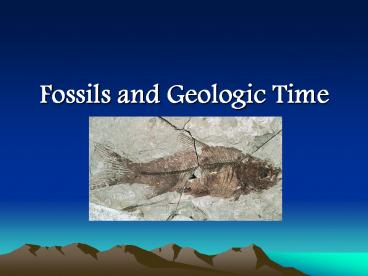Fossils and Geologic Time - PowerPoint PPT Presentation
1 / 35
Title: Fossils and Geologic Time
1
Fossils and Geologic Time
2
The Fossil Record
- Provides evidence about the history of Earth
- Shows how groups of organisms changed over time
3
The Fossil Record
- More than 99 of species that have lived on Earth
are extinct - A very small percentage became fossils
4
How Fossils Form
- Most form in sedimentary rock
- Rock made from compacted particles of sand, silt,
and clay - Organism is buried by sediment shortly after
dying - More layers of sediment are laid down on top of
the dead organism - Compression of layers of sediment prevent decay
of the dead organism
5
(No Transcript)
6
Relative Dating
- Geologists noticed rock layers with certain
fossils consistently appeared in the same
vertical order - Led to relative dating
- Determining the age of a fossil by comparing it
with fossils found above and below it - Does not provide an exact date for the fossil
7
(No Transcript)
8
Radioactive Dating
- Using radioactive decay to assign absolute ages
to rocks and fossils - Scientists know exactly how long it takes
radioactive isotopes to decay to other elements - Also know approximately how much of a radioactive
isotope rocks and living things contain when they
form or are alive
9
Radioactive Dating
- Measured using half lives
- Amount of time for half the amount of a
radioactive isotope found in a rock or living
thing to decay - Different radioactive isotopes decay at different
rates - Examples Carbon-14 5,730 years
- Potassium-40 1.26 billion years
10
Radioactive Dating
- Carbon-14
- All living things contain a lot of Carbon-12
- Also contain a small amount of Carbon-14
- When organisms die they stop taking in C-14 and
it begins to decay into C-12
11
Radioactive Dating
- Carbon-14
- After 5,730 years (one half life) half the C-14
an organism contained when it was alive will be
gone - If an organism contained 20g C-14 at death, 5,730
years later it will contain 10g C-14 - Half the C-14 is gone
12
Radioactive Dating
- Carbon-14
- After 11,460 years (two half lives) half the C-14
an organism contained at the end of the last half
life will be gone - If an organism contained 10g C-14 after one half
life, 5,730 years later it will contain 5g C-14 - One quarter (half x half) the C-14 is gone
13
Grams C-14 remaining
Number of half lives
Years
0 0
1
2
3
14
Grams C-14 remaining
Number of half lives
Years
0 0
1 5,730
2
3
15
Grams C-14 remaining
Number of half lives
Years
0 0
1 5,730
2 11,460
3
16
Grams C-14 remaining
Number of half lives
Years
0 0
1 5,730
2 11,460
3 17,190
17
Grams C-14 remaining
Number of half lives
Years
0 0 20g
1 5,730
2 11,460
3 17,190
18
Grams C-14 remaining
Number of half lives
Years
0 0 20g
1 5,730 10g
2 11,460
3 17,190
19
Grams C-14 remaining
Number of half lives
Years
0 0 20g
1 5,730 10g
2 11,460 5g
3 17,190
20
Grams C-14 remaining
Number of half lives
Years
0 0 20g
1 5,730 10g
2 11,460 5g
3 17,190 2.5g
21
(No Transcript)
22
Radioactive Dating
- Carbon-14
- Because its half life is relatively short it can
only be used on samples younger than 60,000 years
23
Radioactive Dating
- Potassium-40
- Much longer half life 1.26 billion years
- Used for oldest fossils and rocks
- Effective on samples up to 10 billion years old
- Earth is only 4.6 billion years old
24
Geologic Time Scale
- Earths age is estimated at 4.6 billion years
- History of Earth is divided into major sections
- Eons (very long), eras (long), and periods
(shorter)
25
(No Transcript)
26
Geologic Time Scale
- Entire history of Earth is divided into two eons
- Precambrian Eon
- 3.5 billion years ago 550 million years ago
- Life began as single-celled prokaryotes
- Single-celled eukaryotes developed
- By the end multicellular life had developed
27
Geologic Time Scale
- Entire history of Earth is divided into two eons
- Phanerozoic Eon
- 550 million years ago present
- Began with primitive multicellular marine life
- Divided into many eras
28
(No Transcript)
29
(No Transcript)
30
(No Transcript)
31
Geologic Time Scale
- The Phanerozoic eon is divided into three eras
- Paleozoic Era
- 550 mya 245 mya
- Divided into 6 periods
- Began with all life living in seas
- Land organisms developed (forests, insects,
reptiles) - Ended with a mass extinction of 95 of life on
the planet (End-Permian extinction)
32
(No Transcript)
33
Geologic Time Scale
- The Phanerozoic eon is divided into three eras
- Mesozoic Era
- 245 mya 65 mya
- Divided into 3 periods
- Began with the few life forms that survived the
End-Permian extinction - Dinosaurs became dominant, first mammals, first
birds, first flowering plants - Ended with the mass extinction that killed the
dinosaurs (called the K-T Extinction)
34
(No Transcript)
35
Geologic Time Scale
- The Phanerozoic eon is divided into three eras
- Cenozoic Era
- 65 mya present
- Divided into 2 periods
- Began with the few life forms that survived the
K-T extinction - Mammals and insects became dominant, lots of
flowering plants - What will it end with? Current mass extinction?































